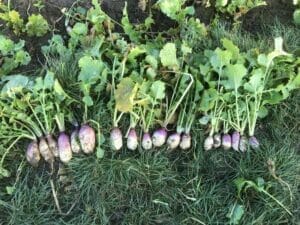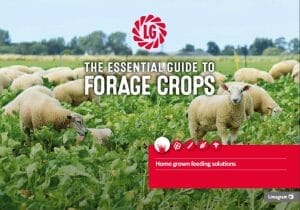United Kingdom
June 6, 2023
We’ve taken a look back on this 2017 trial of stubble turnips to show the advantages of sowing early – ideal for after cereals!
In a Limagrain field trial, on its innovation site in Lincolnshire, three crops of Samson stubble turnips were sown at two-week intervals from July 28, 2017. Fertiliser was applied at 35kg of nitrogen per

Samson stubble turnips
hectare, in the form of 20:10:10, into the seedbed. Crops were harvested by hand in mid-December and weighed. “The results showed that the highest dry matter yields came from those crops sown earliest,” says Limagrain forage crop director Martin Titley. “Dry matter loss was 33% in crops sown two weeks later and 59% in crops sown four weeks later.” Table 1 shows the dry matter yield from the three crops.
TABLE 1 Dry matter yield of Samson stubble turnips t/ha
| Sowing date |
28/7/17 |
15/8/17 |
31/8/17 |
| Samson |
6.6 |
4.4 (-33%) |
2.7 (-59%) |
The trial also highlighted the change in the ratio between leaf and bulb yield over time with those earlier sown crops producing higher yield of bulb to leaf compared with later sown crops. Table 2 shows the ratios of dry matter yield of bulb to leaf across the three sowing dates.
TABLE 2 Percentage Dry matter yield leaf:bulb
| Sowing date |
28/7/17 |
15/8/17 |
31/8.17 |
| Leaf % |
24% |
41% |
62% |
| Bulb % |
76% |
59% |
38% |
Limagrain has used the AHDB relative feed value calculator for stubble turnips of £123.95 per tonne of dry matter, based on feed barley at £120 a tonne and rape meal at £195 a tonne, to illustrate the difference in feed value between the three sowing dates. “The earliest sown crop of Samson has a feed value of £483.40 higher than the crop sown in late August,” adds Mr Titley. “The growing costs of all three crops is the same.” “While this trial shows the yield advantages of earlier sowing, growers should remember that all crops of stubble turnips provide a valuable feedstuff, with later sown crops providing a useful amount of leafy forage.” Stubble turnips are an ideal crop after cereals with only light cultivation required ahead of drilling. They are a fast-growing catch crop, easy to eat and highly palatable that can be grazed by sheep or cattle within 12 to 14 weeks from sowing. “If the timing of the cereal harvest allows a crop of stubble turnips to be sown earlier then there are likely to be yield advantages, but even at the end of August or early September, this crop will still provide a cost-effective forage crop.”
Stubble turnips – yield and feed value
Average DM yield 3-6t/ha
Average fresh yields 38-45t/ha
Dry matter 8-9%
Crude protein 17-18%
Digestibility 68-70%
ME 11MJ/kg DM
For all the up-to-date growing costs and growing information, download the Essential Guide to Forage Crops

LG Essential Guide to Forage Crops